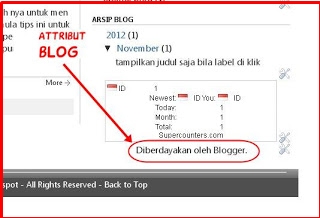
cara menghilangkan attribut blog
Di anggap tidak perlu oleh para blogger attribut blog pun pada di hapus atau di hilangkan dari blog nya.Inilah cara untuk menghilangkan attribut di blog:

- login di blog sobat
- template >> edit HTML
- centang expan widget
- cari kode yang seperti ini:
<b:widget id='Attribution1' locked='true' title='' type='Attribution'>
<b:includable id='main'>
<b:if cond='data:feedbackSurveyLink'>
<div class='mobile-survey-link' style='text-align: center;'>
<data:feedbackSurveyLink/></div></b:if>
<div class='widget-content' style='text-align: center;'>
<b:if cond='data:attribution != ""'>
<data:attribution/></b:if></div>
<b:include name='quickedit'/>
</b:includable> </b:widget>
- bila sudah ketemu kode seperti di atas hapus lah kode tersebut
- klik save template dan akan muncul gambar seperti di bawah ini

semoga ulasan ini bermanfaat dan berguna bagi nusa dan bangsa